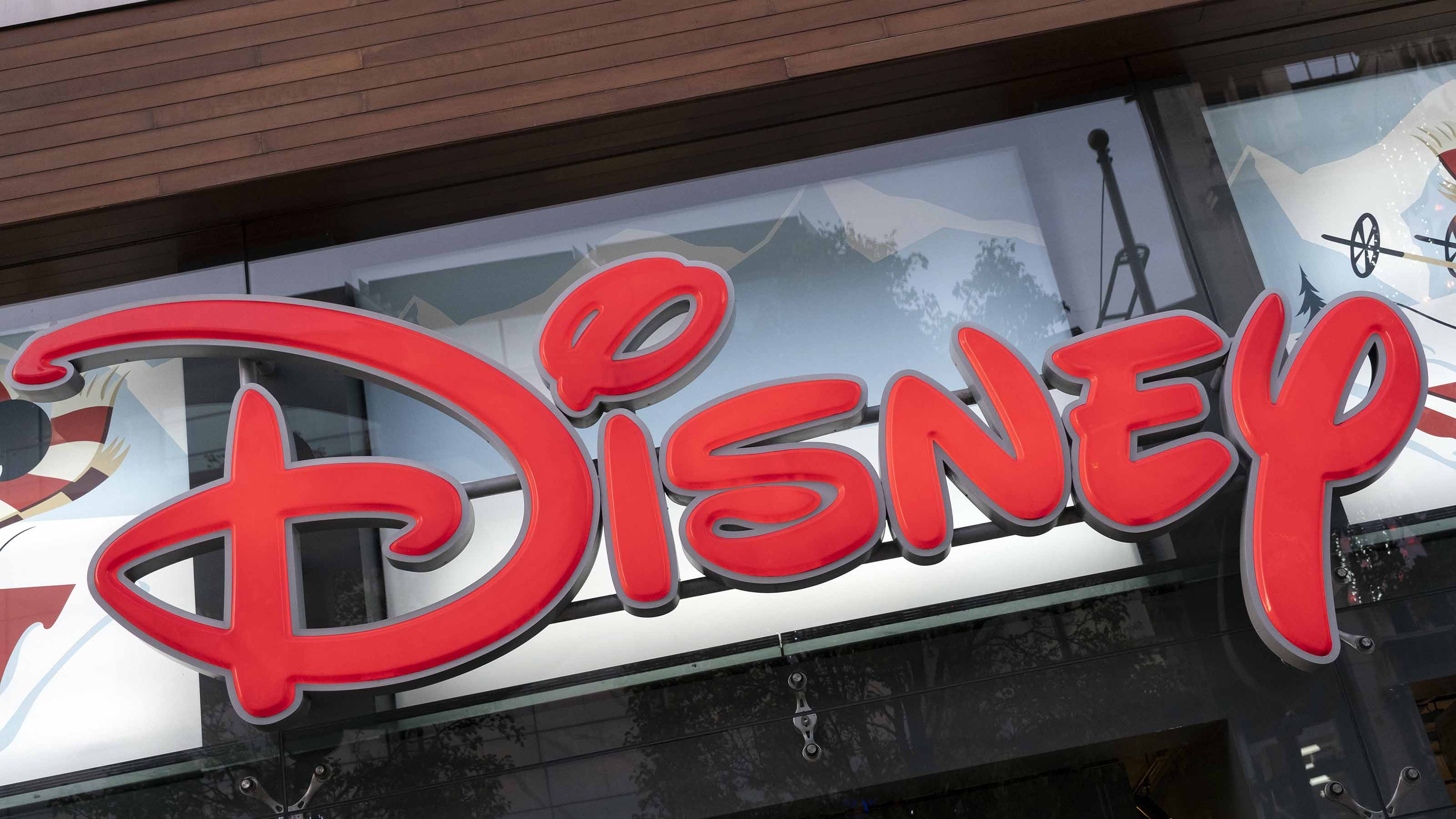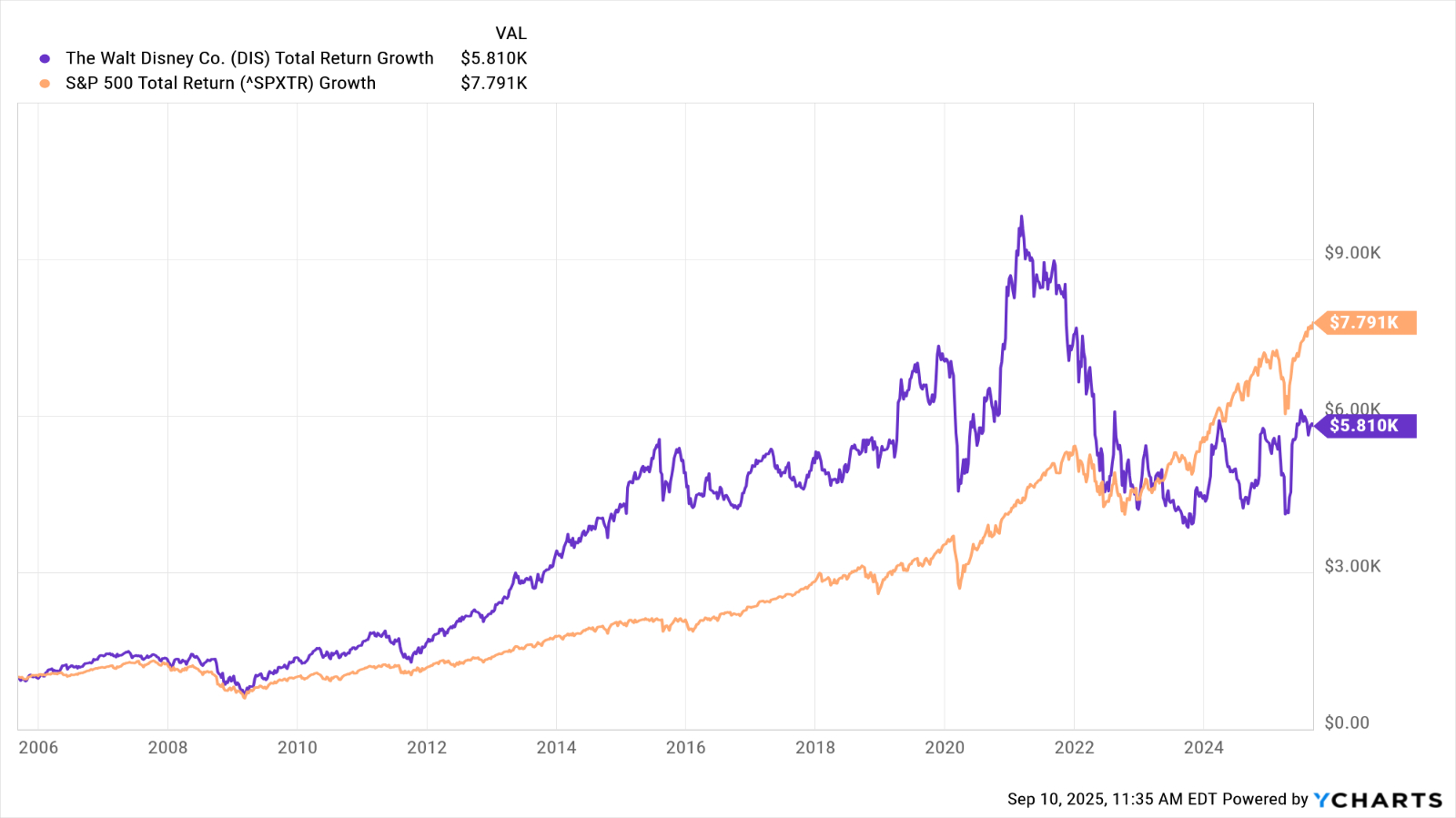If You'd Put $1,000 Into Disney Stock 20 Years Ago, Here's What You'd Have Today
Long-time market laggard Disney stock has been a buy-and-hold bust.



Walt Disney (DIS) stock is showing signs of life again vs the broader market, but long-term shareholders might be forgiven if they've grown impatient with their returns.
Disney was having a terrific 2024 through late May. Shares were up 35% for the year to date, making DIS the best-performing component of the Dow Jones Industrial Average.
Then the bottom fell out. The media and entertainment giant's revenue came up short of Wall Street's expectations. DIS stock predictably paid the price.
From just $107.88 $24.99 for Kiplinger Personal Finance
Become a smarter, better informed investor. Subscribe from just $107.88 $24.99, plus get up to 4 Special Issues

Sign up for Kiplinger’s Free Newsletters
Profit and prosper with the best of expert advice on investing, taxes, retirement, personal finance and more - straight to your e-mail.
Profit and prosper with the best of expert advice - straight to your e-mail.
Wall Street, however, continued to be bullish on the name — and that turned out to be a canny call for traders. After all, DIS stock went on to rally sharply off its summer nadir.
For all of 2024, however, DIS once again lagged the performance of the S&P 500 — an all-too-frequent occurrence. Indeed, shares underperformed the broader market through the first eight-plus months of 2025, too.
That's just how it's been for a good long while. On an annualized total return basis (price change plus dividends), DIS comes up well short of the broader market over pretty much any standardized period you care to measure beyond the past year.
Everyone remembers how the pandemic clobbered Disney, whose theme parks and film businesses were epically exposed to COVID-19. Dividend investors certainly recall that the company suspended its payout in the early months of the outbreak to conserve cash.
Disney reinstated the dividend at the end of 2023. It was welcome news for income investors and certainly helped bolster the share price.
Perhaps fewer remember how DIS stock more than doubled from March 2020 to March 2021, when shares hit an all-time high as a pandemic recovery play. At the top, Disney boasted a market cap of more than $366 billion.
What Disney shareholders would probably like to forget is that DIS is still far below its peak. Shares have lost more than 40% of their value since hitting a closing high back in March 2021, shedding more than $160 billion in market value in the process.
To put such a sum in context, that's more than the market values of six of 30 Dow Jones stocks, including Amgen (AMGN), Honeywell International (HON) and Nike (NKE).
DIS was one of the 30 best stocks in the world in the three decades ended 2020. What happened?
The rise of streaming and other tectonic changes in the past decade have Disney facing tough questions.
If CEO Bob Iger's first tenure was all about acquiring assets and making Disney bigger, his sequel run as top executive is all about remaking Disney for the new competitive landscape.
The bottom line on Disney stock
As noted above, Disney was one of the best stocks in the world over the three decades from 1990 to 2020. Mostly, though, it's been a huge bust.
While it's true that you can manipulate historical returns by fussing with their beginning and end points, Disney's record vs the broader market over pretty much any standardized period you care to measure is terrible.
For its entire history as a publicly traded company, Disney stock has generated an annualized total return of 8.2%. That trails the S&P 500 by about 2.5 percentage points.

The past two decades have been only a little better for Disney, with shares returning 9.2% vs 10.8% for the broader market.
To get a sense of what this underperformance looks like on a brokerage statement, have a gander at the above chart. Note that if you put $1,000 into Disney stock 20 years ago, it would be worth about $5,800 today.
The same amount invested in the S&P 500 two decades ago would theoretically be good for about $7,800 today.
Disney shareholders expected more. If they feel those returns are disappointing, they are not wrong.
If there's a sliver of a silver lining for buy-and-hold Disney investors, at least Wall Street likes its chances of beating the market in the next 12 to 18 months.
Of the 30 analysts issuing opinions on DIS stock surveyed by S&P Global Market Intelligence, 19 rate it at Strong Buy, four say Buy, six have it a Hold, and one calls it a Strong Sell. That works out to a consensus recommendation of Buy, with strong conviction.
More Stocks of the Past 20 Years
- If You'd Put $1,000 Into Intel Stock 20 Years Ago, Here's What You'd Have Today
- If You'd Put $1,000 Into IBM Stock 20 Years Ago, Here's What You'd Have Today
- If You'd Put $1,000 Into Apple Stock 20 Years Ago, Here's What You'd Have Today
Profit and prosper with the best of Kiplinger's advice on investing, taxes, retirement, personal finance and much more. Delivered daily. Enter your email in the box and click Sign Me Up.

Dan Burrows is Kiplinger's senior investing writer, having joined the publication full time in 2016.
A long-time financial journalist, Dan is a veteran of MarketWatch, CBS MoneyWatch, SmartMoney, InvestorPlace, DailyFinance and other tier 1 national publications. He has written for The Wall Street Journal, Bloomberg and Consumer Reports and his stories have appeared in the New York Daily News, the San Jose Mercury News and Investor's Business Daily, among many other outlets. As a senior writer at AOL's DailyFinance, Dan reported market news from the floor of the New York Stock Exchange.
Once upon a time – before his days as a financial reporter and assistant financial editor at legendary fashion trade paper Women's Wear Daily – Dan worked for Spy magazine, scribbled away at Time Inc. and contributed to Maxim magazine back when lad mags were a thing. He's also written for Esquire magazine's Dubious Achievements Awards.
In his current role at Kiplinger, Dan writes about markets and macroeconomics.
Dan holds a bachelor's degree from Oberlin College and a master's degree from Columbia University.
Disclosure: Dan does not trade individual stocks or securities. He is eternally long the U.S equity market, primarily through tax-advantaged accounts.
-
 Holiday Tax Scams: 'Tis the Season to be Wary
Holiday Tax Scams: 'Tis the Season to be WaryTax Scams Navigating tax tricks of the holiday season may be daunting, but don't let that destroy your festive spirit
-
 Metro by T-Mobile Is Giving Away This Samsung Galaxy A16: Which Plans Are Eligible?
Metro by T-Mobile Is Giving Away This Samsung Galaxy A16: Which Plans Are Eligible?Metro by T-Mobile is offering free Samsung Galaxy A16 phones on eligible plans right now. Here’s how the deal works.
-
 I Drive and Collect Classic Cars: Here’s How I Got Started
I Drive and Collect Classic Cars: Here’s How I Got StartedAre classic cars a hobby or an investment strategy — or both? Either way, the vintage car scene is much cooler and more affordable than you think.
-
 The $183,000 RMD Shock: Why Roth Conversions in Your 70s Can Be Risky
The $183,000 RMD Shock: Why Roth Conversions in Your 70s Can Be RiskyConverting retirement funds to a Roth is a smart strategy for many, but the older you are, the less time you have to recover the tax bite from the conversion.
-
 A Financial Pro Breaks Retirement Planning Into 5 Manageable Pieces
A Financial Pro Breaks Retirement Planning Into 5 Manageable PiecesThis retirement plan focuses on five key areas — income generation, tax management, asset withdrawals, planning for big expenses and health care, and legacy.
-
 4 Financial To-Dos to Finish 2025 Strong and Start 2026 on Solid Ground
4 Financial To-Dos to Finish 2025 Strong and Start 2026 on Solid GroundDon't overlook these important year-end check-ins. Missed opportunities and avoidable mistakes could end up costing you if you're not paying attention.
-
 Nasdaq Leads as Tech Stages Late-Week Comeback: Stock Market Today
Nasdaq Leads as Tech Stages Late-Week Comeback: Stock Market TodayOracle stock boosted the tech sector on Friday after the company became co-owner of TikTok's U.S. operations.
-
 Are You Putting Yourself Last? The Cost Could Be Your Retirement Security
Are You Putting Yourself Last? The Cost Could Be Your Retirement SecurityIf you're part of the sandwich generation, it's critical that you don't let the needs of your aging parents come at the expense of your future.
-
 I'm an Insurance Pro: It's Time to Prepare for Natural Disasters Like They Could Happen to You
I'm an Insurance Pro: It's Time to Prepare for Natural Disasters Like They Could Happen to YouYou can no longer have the mindset that "that won't happen here." Because it absolutely could. As we head into 2026, consider making a disaster plan.
-
 The Future of Philanthropy Is Female: How Women Will Lead a New Era in Charitable Giving
The Future of Philanthropy Is Female: How Women Will Lead a New Era in Charitable GivingWomen will soon be in charge of trillions in charitable capital, through divorce, inheritance and their own investments. Here's how to use your share for good.
-
 Cooler Inflation Supports a Relief Rally: Stock Market Today
Cooler Inflation Supports a Relief Rally: Stock Market TodayInvestors, traders and speculators welcome much-better-than-hoped-for core CPI data on top of optimism-renewing AI earnings.